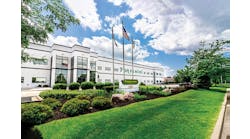Smithfield Foods’ Orange City, Iowa, facility was built in 1972, an era in which energy efficiency was just appearing on the radar and sustainability simply meant keeping the plant in operation by making as much product as possible as cheaply as possible.
Fast-forward to the 21st century, when energy is a cost concern but moreso a component of natural resource depletion and greenhouse gas emissions. And corporate responsibility reports are almost as necessary as 10-K's. The Orange City plant began setting goals for sustainability in 2014 and in the next two years embarked on a number of programs to propel it to the forefront of sustainable manufacturing.
Using 2014 as a baseline for comparisons, the Smithfield plant, which makes pet food blends and treats, has reduced energy usage by 12%, water usage by 31%, and greenhouse gas emissions by 29%, while increasing production by 22% (it now has an annual production volume of over 100 million lbs.). And it achieved third-party ISO 14001:2015 certification based on its comprehensive Environmental Management System.
The facility also achieved zero-waste-to-landfill certification in 2018 through increased recycling and waste reduction and by partnering with a local provider to recycle cardboard and plastic material used for packaging. Additionally, materials from the plant previously determined as waste for the landfill are now used to generate renewable energy at a private waste-to-energy facility.
"Sustainability and operating efficiency are both really important to Smithfield Foods as a whole," says Paul McLeod, plant manager. "We have a lot of targets as a company, and each plant gets the opportunity to work toward achieving those goals."
"As a corporation, sustainability has been ingrained in our DNA. It's a huge part of who we are and what we do," adds John Meyer, senior director of environmental affairs. "We have corporate goals across our entire, global supply chain of:
- Reducing greenhouse gas emissions by 25% by 2025
- Reducing energy usage 5% by 2020
- Reducing water usage 10% by 2020
- Reducing solid waste 75% and achieving zero-waste-to-landfill certification at 75% of our U.S. processing facilities by 2025."
In the case of the Orange City plant, energy use has been reduced through a handful of projects. The plant is about 70% through the replacement of traditional light bulbs with LEDs. All new and replacement equipment is energy-efficient.
"It's also important where the electricity comes from," says Meyer. "We're fortunate that the electrical supplier in our area has a robust renewable energy portfolio. A significant chunk of the energy supplied to our facility, and others in the region, was renewable energy, which reduces greenhouse gas emissions."
Water also is saved by proper use of nozzles and pressure, and making sure hoses are completely turned off after use. "It really was a people education thing," says McLeod. Managers also found they could reduce some sanitation cycles. Altogether, water use was reduced by 3 million gallons in 2017 alone (over 2016), "and it's going down every year," McLeod adds. "When you save 3 million gallons of water a year, you're also saving energy."
But perhaps the Orange City plant's biggest environmental accomplishment has been in waste reduction. "In 2016 we began working toward zero landfill status," says McLeod. "We were sending more than a million pounds a year to landfill."
It didn't involve a big capital outlay and it took two years to work out – there was a lot of coordination with recyclers and education of employees. But plant officials found recyclers for all the corrugated, plastic, metals and paper. "We found a home for everything," says McLeod.
"One of our biggest waste streams is wastewater residuals," says Meyer. "We run all our wastewater through dissolved air flotation units, but the solids, the grease, we skim away and it gets land-applied in the spring and fall. The farmers love it. That's a big amount of waste material that goes to a beneficial reuse."
Corrugated totes and their plastic liners formerly were reusable somewhat, but eventually wore out and became waste. They were replaced with plastic totes that are reusable and easy to clean.
For the 10th year, we asked readers to help us honor the best recent examples of green or sustainable processing plants. Back in July, we whittled down a handful of nominations to three: Chobani's Twin Falls, Idaho, yogurt-making plant; ISO Group's Riverside, Calif., facility; and Smithfield Foods' Orange City, Iowa, pet food plant.
We asked each facility for 200-word essays to help familiarize readers with their efforts. Then we put all three essays and a poll on our web site, and nearly 500 readers picked the winner: Smithfield Foods. That plant joins our previous winners, which you can find in our Green Plant of the Year Award section.
In nominations and the final vote, we listed several points we were looking for in a Green Plant of the Year:
- Is it energy efficient?
- Does it use innovative or alternative sources of energy?
- It is minimally polluting?
- Does it minimize water use?
- Were green building materials and practices used in its construction?
- Is the design innovative?
- Is it economically sustainable?
"Any material we can't find a recyclable home for goes to a private company in Manketo, Minn., that burns the material to generate electricity.
"A lot of people, companies in the local community, are asking them how they did it, wanting to emulate what they did," says Meyer. "The plant has become a shining star for sustainability in the Orange City area."
In addition to the environmental benefits, "we even receive money back for some of the recyclables," notes McLeod.
In 2013, the plant qualified for ISO 14001, an international quality standard for effective Environmental Management Systems (EMS). The standard provides a framework an organization can use to enhance its environmental performance, managing its environmental responsibilities in a systematic manner that contributes to the environmental pillar of sustainability. An effective EMS should provide value for the environment, the organization itself and other interested parties.
Last year, the Orange City plant was among 43 Smithfield facilities recognized by North American Meat Institute (NAMI) for environmental achievements (as well as 24 company locations NAMI cited for workplace safety accomplishments). The NAMI Environmental Awards program recognizes companies that go beyond compliance by developing and implementing innovative environmental programs. It is a four-tiered program beginning with simple environmental compliance policies in Tier 1 and culminating with the more complex ISO 14001 Environmental Management Systems (EMS) as Tier 4.
The facility’s sustainability efforts extend into the local community with the ongoing support of the National Conservation Foundation Envirothon program, which engages students in environmental problem-solving.
"There is another benefit: employee pride," adds Meyer. "Leadership takes great pride in these efforts and so does every employee. It makes them proud of everything they do. It comes down to culture and leadership, and Paul and his team have ingrained this mindset in all their employees. It helps with morale and it helps with retention. When employees have pride in their job, they do a better job."


